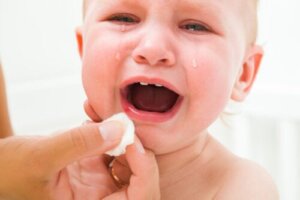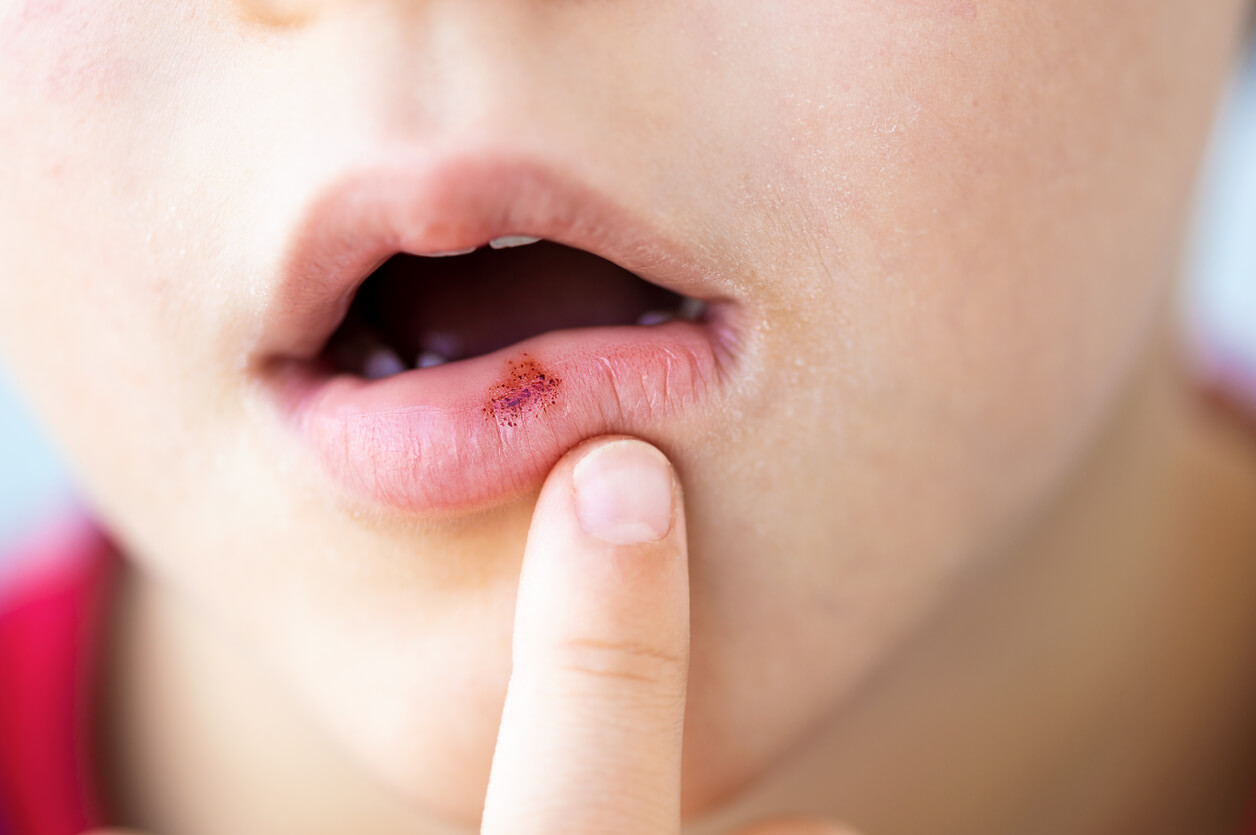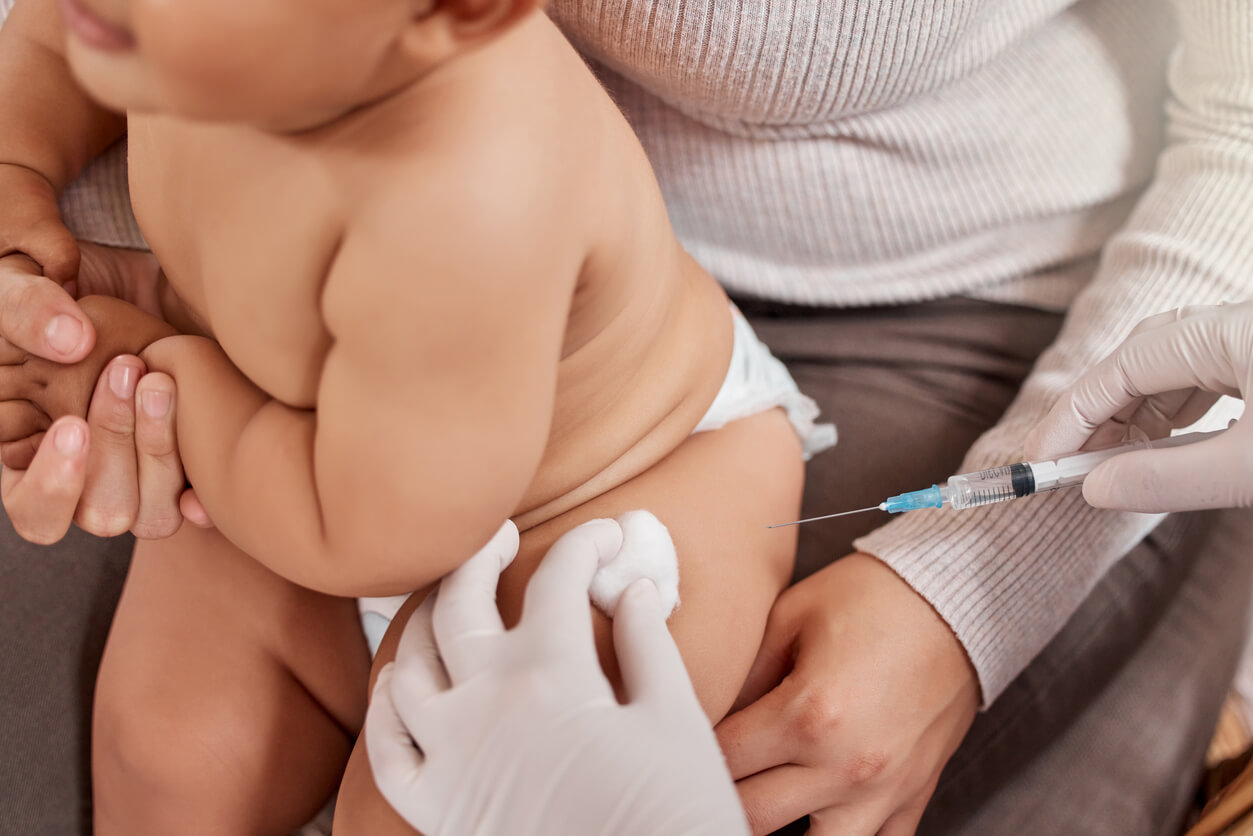Cold Sores in Infants: Causes, Symptoms, and Treatment


Written and verified by the dermatologist Maria del Carmen Hernandez
Cold sores in infants are an infrequent condition. However, when they do occur, they can lead to important complications due to the immaturity of the child’s immune system. For this reason, it’s essential to know more about them, distinguish their main characteristics, and know how to prevent them in the most appropriate way.
The causes of cold sores in infants
Cold sores are quite common among the adult population and among children. In fact, the virus that triggers it is usually harmless and resolves spontaneously. In the case of infants and children, the lesions are caused by herpes simplex virus type 1 (HSV-1), unlike in adults, where HSV-2 is also usually involved.
- Herpes simplex virus type 1 is the causative agent of facial herpes, including cold sores in infants. This type of virus is the most common and is transmitted fairly easily from person to person by saliva or direct contact. According to publications of the American Academy of Pediatrics, the virus is activated by fever, a sunburn, rubbing, or stress.
- Herpes simplex virus type 2: This variant is more complex because it causes lesions on the genitals. It’s transmitted through sexual contact.
A newborn baby can contract the virus at birth vaginally if the mother has genital herpes. It can even be transmitted in utero or after birth and is spread quite easily through saliva or skin-to-skin contact.
You may be interested in: The 10 Most Common Skin Problems in the First Year of Life

The clinical manifestations of cold sores in infants
Cold sores in infants appear in the form of small whitish, pink, or colored blisters. In most cases, they appear in or around the mouth and lips. They may even develop on the nose, cheeks, chin, or other parts of the face. The blisters are oval or round and may ooze a clear, serous fluid which then crusts over. They then tend to disappear on their own within a few weeks.
Some of the symptoms or signs in children are as follows:
- Mild pain and discomfort on swallowing
- Fever
- General discomfort
- Itching and burning
Differential diagnosis
Blisters can cause erythema on the delicate skin of infants and ooze all together. Because of this, it’s often confused with infantile acne or eczema. However, cold sore blisters are larger than acne lesions and higher than eczema lesions.
Read also: Infant skin care
Treatment options for cold sores in infants
Neonatal herpes is rare and dangerous. What’s more, according to the National Health Service, the younger the infant, the more severe the oral manifestations will be. In these cases, the most important thing to do is to consult a specialist urgently. In this regard, babies with cold sores, especially those under 6 months of age with other risk factors or newborns should receive medical treatment to combat the virus.
Injectable medication
The use of injectable antiviral drugs can help the baby’s immune system to function better. In addition, if the lesions are widespread, the infant may have severe pain and discomfort that’s controlled with the use of acetaminophen or another type of pain reliever. This type of medication must be prescribed by a pediatrician together with the respective doses to be administered.
Topical medication
Topical antiviral creams are used for skin lesions caused by the virus. For example, acyclovir is used to soothe local symptoms and prevent possible infection of the area. Ointment, in addition to helping to soothe the signs and symptoms, accelerates healing and scarring.

Care measures
In addition to medication, various care and hygiene measures are often recommended to soothe the discomfort and inflammation of the area:
- Apply cold water cloths on the injured area.
- Use liquid or soft foods.
- Wash hands before touching the baby.
- Don’t kiss the baby in the presence of cold sores.
- Respect the vaccination schedule (chickenpox vaccine).
Can complications occur?
In infants who aren’t diagnosed early, the lesions can spread over the entire skin surface. In addition, they can cause inflammation of the nervous system and damage to internal organs. If an infection develops inside the uterus, it can even cause miscarriage, brain malformations, and growth retardation.
Complications of the virus often include lethargy, convulsions, high fever, and irritability. Herpetic encephalitis is even one of the most dangerous complications.
Cold sores in infants are often not so harmless
While cold sores in the elderly and in children are usually a harmless condition, in infants they can be more dangerous and serious. Moreover, they’re a rare condition in newborns and can present serious systemic complications and major health alterations.
Cold sores in infants are an infrequent condition. However, when they do occur, they can lead to important complications due to the immaturity of the child’s immune system. For this reason, it’s essential to know more about them, distinguish their main characteristics, and know how to prevent them in the most appropriate way.
The causes of cold sores in infants
Cold sores are quite common among the adult population and among children. In fact, the virus that triggers it is usually harmless and resolves spontaneously. In the case of infants and children, the lesions are caused by herpes simplex virus type 1 (HSV-1), unlike in adults, where HSV-2 is also usually involved.
- Herpes simplex virus type 1 is the causative agent of facial herpes, including cold sores in infants. This type of virus is the most common and is transmitted fairly easily from person to person by saliva or direct contact. According to publications of the American Academy of Pediatrics, the virus is activated by fever, a sunburn, rubbing, or stress.
- Herpes simplex virus type 2: This variant is more complex because it causes lesions on the genitals. It’s transmitted through sexual contact.
A newborn baby can contract the virus at birth vaginally if the mother has genital herpes. It can even be transmitted in utero or after birth and is spread quite easily through saliva or skin-to-skin contact.
You may be interested in: The 10 Most Common Skin Problems in the First Year of Life

The clinical manifestations of cold sores in infants
Cold sores in infants appear in the form of small whitish, pink, or colored blisters. In most cases, they appear in or around the mouth and lips. They may even develop on the nose, cheeks, chin, or other parts of the face. The blisters are oval or round and may ooze a clear, serous fluid which then crusts over. They then tend to disappear on their own within a few weeks.
Some of the symptoms or signs in children are as follows:
- Mild pain and discomfort on swallowing
- Fever
- General discomfort
- Itching and burning
Differential diagnosis
Blisters can cause erythema on the delicate skin of infants and ooze all together. Because of this, it’s often confused with infantile acne or eczema. However, cold sore blisters are larger than acne lesions and higher than eczema lesions.
Read also: Infant skin care
Treatment options for cold sores in infants
Neonatal herpes is rare and dangerous. What’s more, according to the National Health Service, the younger the infant, the more severe the oral manifestations will be. In these cases, the most important thing to do is to consult a specialist urgently. In this regard, babies with cold sores, especially those under 6 months of age with other risk factors or newborns should receive medical treatment to combat the virus.
Injectable medication
The use of injectable antiviral drugs can help the baby’s immune system to function better. In addition, if the lesions are widespread, the infant may have severe pain and discomfort that’s controlled with the use of acetaminophen or another type of pain reliever. This type of medication must be prescribed by a pediatrician together with the respective doses to be administered.
Topical medication
Topical antiviral creams are used for skin lesions caused by the virus. For example, acyclovir is used to soothe local symptoms and prevent possible infection of the area. Ointment, in addition to helping to soothe the signs and symptoms, accelerates healing and scarring.

Care measures
In addition to medication, various care and hygiene measures are often recommended to soothe the discomfort and inflammation of the area:
- Apply cold water cloths on the injured area.
- Use liquid or soft foods.
- Wash hands before touching the baby.
- Don’t kiss the baby in the presence of cold sores.
- Respect the vaccination schedule (chickenpox vaccine).
Can complications occur?
In infants who aren’t diagnosed early, the lesions can spread over the entire skin surface. In addition, they can cause inflammation of the nervous system and damage to internal organs. If an infection develops inside the uterus, it can even cause miscarriage, brain malformations, and growth retardation.
Complications of the virus often include lethargy, convulsions, high fever, and irritability. Herpetic encephalitis is even one of the most dangerous complications.
Cold sores in infants are often not so harmless
While cold sores in the elderly and in children are usually a harmless condition, in infants they can be more dangerous and serious. Moreover, they’re a rare condition in newborns and can present serious systemic complications and major health alterations.
All cited sources were thoroughly reviewed by our team to ensure their quality, reliability, currency, and validity. The bibliography of this article was considered reliable and of academic or scientific accuracy.
- Overall JC Jr. Herpes simplex virus infection of the fetus and newborn. Pediatr Ann. 1994 Mar;23(3):131-6. doi: 10.3928/0090-4481-19940301-06. PMID: 8015861.
- Pinninti SG, Kimberlin DW. Preventing herpes simplex virus in the newborn. Clin Perinatol. 2014 Dec;41(4):945-55. doi: 10.1016/j.clp.2014.08.012. Epub 2014 Sep 27. PMID: 25459782; PMCID: PMC4386734.
- Guergué Diaz de Cerio O, Rubio Lombraña M, Barrutia Borque A, González Hermosa MR. Father-to-Newborn Transmission of Herpes Simplex Virus Infection: A Sweet but Bitter Kiss. Actas Dermosifiliogr. 2016 Nov;107(9):797-798. English, Spanish. doi: 10.1016/j.ad.2016.04.011. Epub 2016 May 19. PMID: 27210517.
This text is provided for informational purposes only and does not replace consultation with a professional. If in doubt, consult your specialist.








